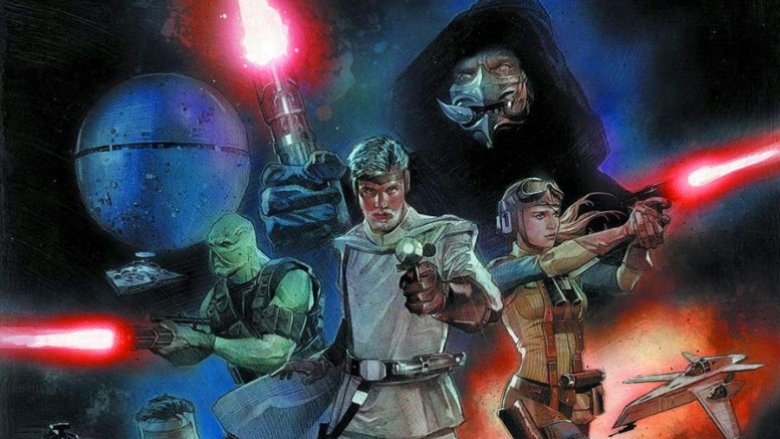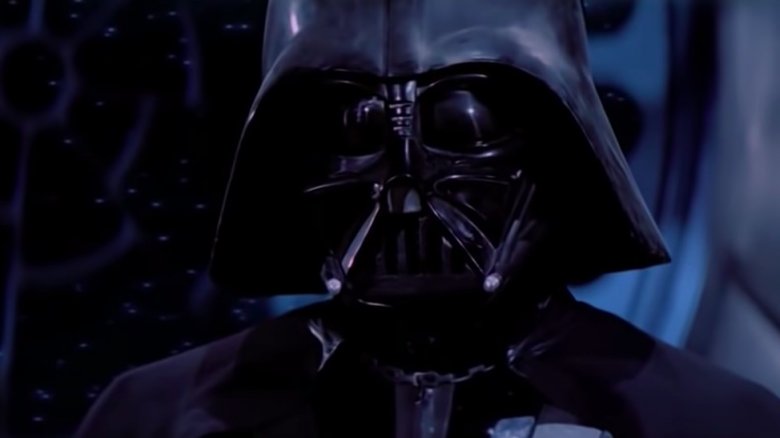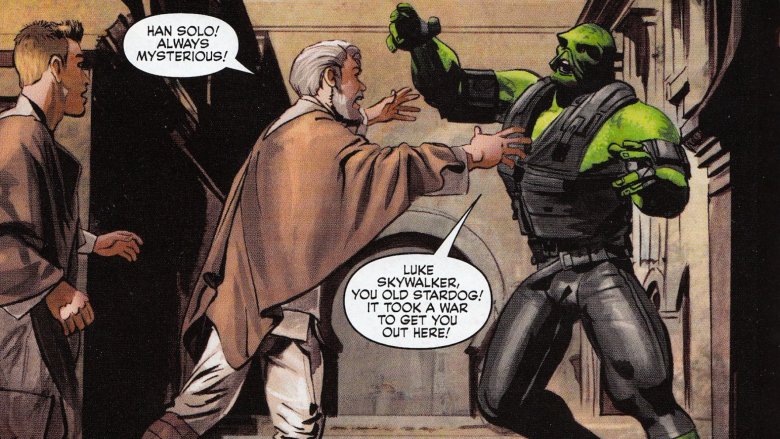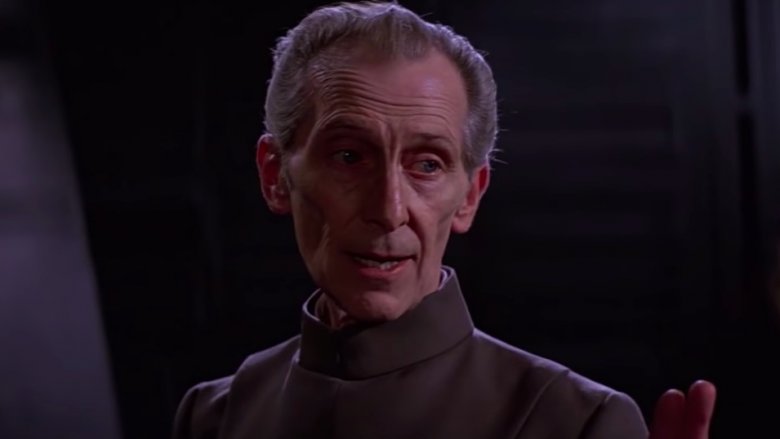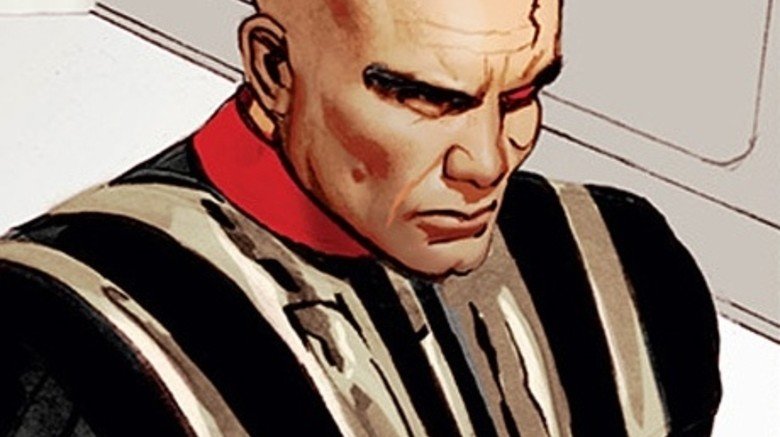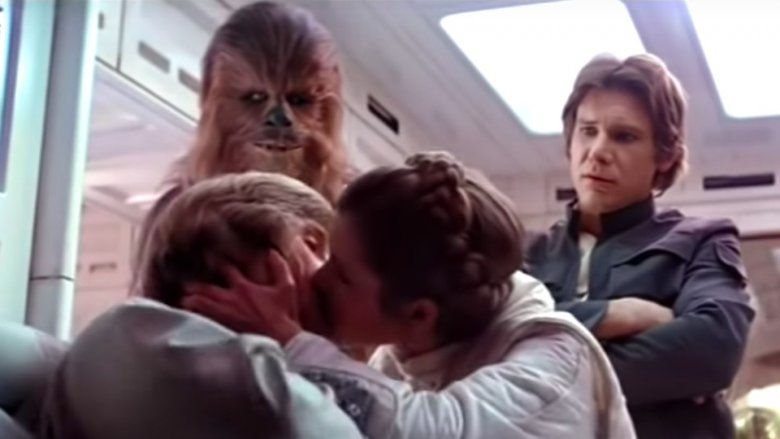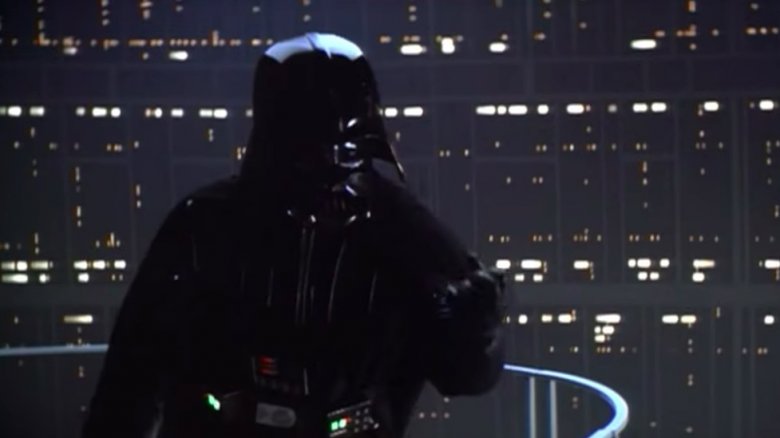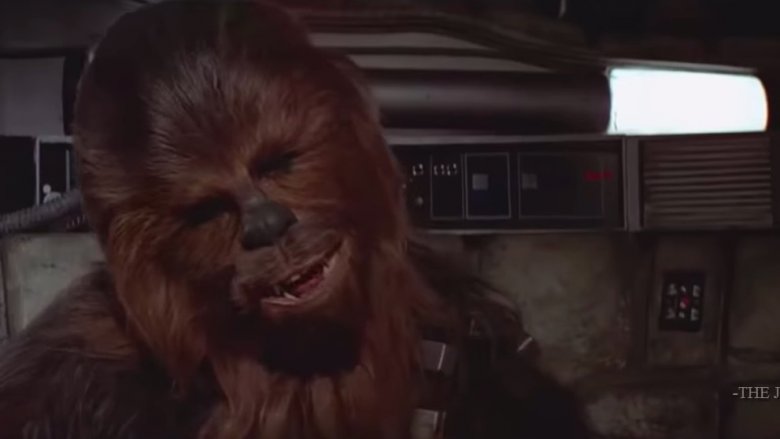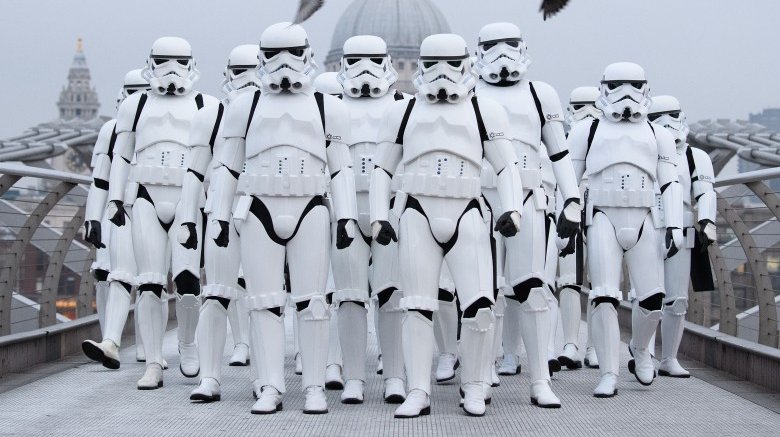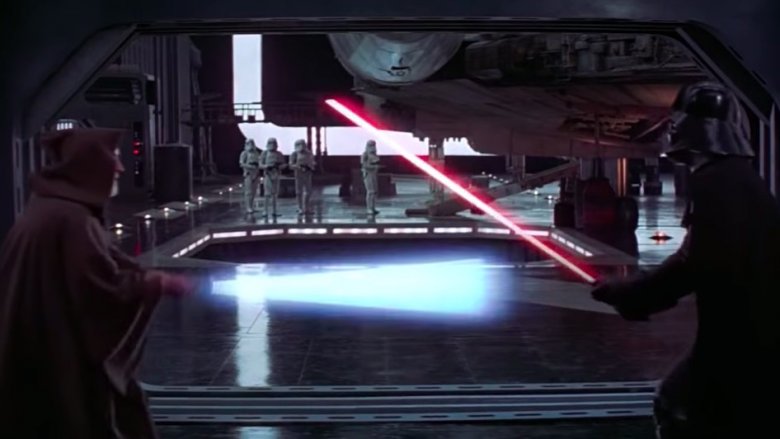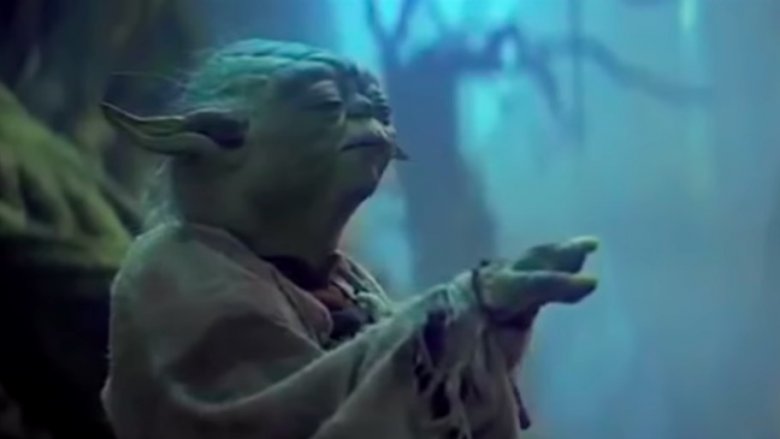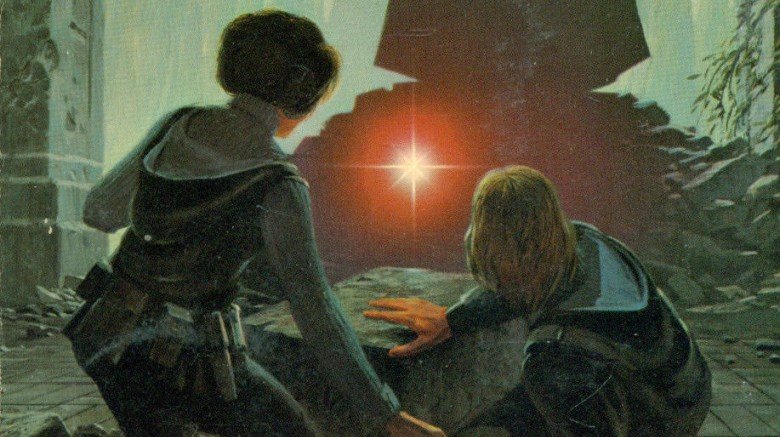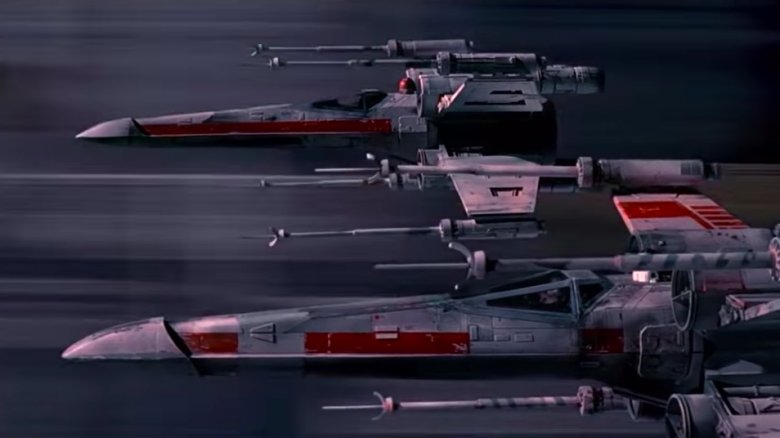The Untold Truth Of The Original Star Wars
You probably thought you knew everything about Star Wars. After all, you've seen it like 750 billion times. You can recite all the dialogue from the very first scene to the very last. You could even act out the entire film non-verbally, provided you could find someone geeky enough to want to watch you. So is there anything you don't know about Star Wars?
Depending on which level geek you actually are, there's some stuff deeply buried in the early history of the Star Wars saga that you might not be familiar with. Changed scripts, altered characters, sequels that never were, and monkeys that were denied their big break — it's all in the archives of obscure Star Wars history. And if you do already know all this, well, you are clearly a mini-god, or perhaps a Sith lord. Well, fellow Star Wars obsessive, there's only one way to know for sure...
James Earl Jones got stiffed
One of the most iconic villains of the 1970s, and let's face it, of any era, is Darth Vader. That long, sweeping cape that for some reason never got embarrassingly caught on anything, that famous shiny black helmet with a mouth that looks like the cow catcher on the front of an old locomotive, that weird, breathy "hooooh puuhhhr" thing that he does — Darth Vader is emblematic of sci-fi villainy. All that iconic Darth Vaderism must have taken months of character development and endless hours in a recording studio, right?
Nope. James Earl Jones recorded all of Darth Vader's original lines in less than half a day. "We did it in two and a half hours," he said in a 2011 interview with the Hollywood Reporter. "I got paid seven thousand dollars for it. Nobody at the time knew that it would become a cult hit. ... I'm very happy to be a part of that cult, even though I didn't get paid a lot for it."
Well, $7,000 sounds like kind of a lot of money for two and a half hours of work (with inflation, it would be about $27,000 today), but maybe it wasn't a huge payday compared to some Hollywood actors. We're not going to feel too sorry for the guy, though. He doesn't seem to be as forthcoming about his salary for the follow-up movies, but it's probably pretty safe to say that he got a raise.
Han Solo was originally green
Han Solo has that Harrison Ford handsomeness, the dangerous outlaw attitude, the witty banter, the pretending-like-he-really-hates-the-princess-when-he's-clearly-into-her thing that he does — everyone loves Han Solo, except Harrison Ford, who once famously described his character as "Ham Yoyo." It's hard for the rest of us to imagine anyone else as Han Solo, though, and it's even harder to imagine anyone other than a human as Han Solo — but Han's earliest incarnation had him looking less like Harrison Ford and more like how Thanos would have looked if he were actually biologically related to his daughter Gamora.
According to Wired, in the first draft of Star Wars: A New Hope, Han Solo is a giant green alien. This strange look for everyone's favorite smuggler eventually even made it to a comic book adaptation of the original Star Wars script, and Han isn't the only thing that's totally upside down. In the comic, R2-D2 can talk, the young farm boy is called Annikin Starkiller, and Luke Skywalker is an older Jedi who is a wise general and not at all spoiled and bratty. Also, most of the story is wasted on political intrigue. Yes it's true, there are usually very good reasons why early drafts don't become final drafts.
Peter Cushing's feet hurt
In Star Wars: A New Hope, Peter Cushing plays Grand Moff Wilhuff Tarkin, the soulless, mostly emotionless Tywin Lannister ripoff (or is it the other way around?) who orders the destruction of Alderaan and spends most of the rest of the movie exuding evil. But we mostly don't get to see his feet. Not that we would want to see his feet, especially, but there's an amusing reason why there aren't that many full body shots of Tarkin — because Cushing hated the boots that went with his costume and wore slippers on set instead.
In his defense, he wasn't just being a prima donna or anything. Den of Geek says the costume department wasn't aware of how large his feet were, and they didn't have time to redo the pair they'd originally given him. In an interview, Cushing later described how he explained the problem to George Lucas. "'George, I am not asking for close-ups,'" he remembered saying. "'But do you think you could shoot me from the waist upwards from now on?' and he said, 'why?' and I explained the reason ... and he gave me a pair of carpet slippers. So for the rest of the film I stomped around looking extremely angry and very cross with that dear little Carrie Fisher as Grand Moff Tarkin in carpet slippers."
The original Darth Vader was just some dude
Characters evolve over time — for proof of that, just look at Wolverine circa 1974 and Wolverine circa Logan. But the Darth Vader we've always known is the same black-caped, shiny-domed, heavy breathing guy who appeared in the first Star Wars movie, and it's really hard to imagine that he was ever anything else. In the original script, though, Darth Vader would have been hard to pick out of a crowd, especially a crowd of extras on the set of Seven Samurai.
According to Force Material, original Vader was "a little, hunched, evil, rat-like person" dressed in silky robes that "fluttered" whenever he walked into a room, and his helmet was supposed to be like a feudal Japanese kabuto, which kind of has the same basic shape as Vader's helmet, only without the front.
So he was kind of sketched out like that, and then it occurred to concept artist Ralph McQuarrie that Vader would need to breathe in space, so the full face mask was added. Originally, the mask was supposed to only be used in space, but Lucas thought the look was so cool that he couldn't bear for Vader to part with it while onboard an oxygen-rich spacecraft. "I think George felt that keeping Vader always in his mask would be fascinating — like an actor in an old Greek tragedy. But it all came to pass because I thought he needed a mask to breathe," McQuarrie later said.
Leia wasn't supposed to be Luke's sister, hence the kissing
Now that Game of Thrones is behind us, we're all super cool with the idea of brothers and sisters getting cozy in really, really taboo ways. Wait, no, most people are not super cool with any of that stuff and never will be. So whenever you rewatch the original Star Wars trilogy you get to relive that very cringeworthy moment when Leia plants a gigantic kiss on Luke's mouth, and Luke is obviously, horrifyingly, disturbingly into it.
Well, knowing what you know now about Luke and Leia's biological relationship, you might wonder what Lucas was thinking. Although he hasn't exactly ever admitted that he did not, messiah-like, know everything that was going to happen in Star Wars from the very beginning, most people believe Luke and Leia weren't originally supposed to be siblings because otherwise why, George, just why? In fact CBR says that in the original draft of The Empire Strikes Back, the ghost of Anakin Skywalker visits Luke and tells him about a mysterious sister called Nellith (her name was later crossed out), and in subsequent revisions there was a scene where Luke and Leia discuss their romantic feelings and another one where they almost kiss again, so eww. They were either not intended to be related or Lucas was hoping they'd both end up in therapy at the end of the rebellion.
Darth Vader wasn't supposed to be Luke's dad
If George Lucas had gone with his original plan, we would never have had that iconic "I am your father" scene, which means we would have missed out on a lifetime of memes, parodies, and perpetual dad jokes. Who would want to live in that world?
According to the Huffington Post, in the original script for Empire Strikes Back, Luke was supposed to meet the ghost of Obi-Wan Kenobi and also the ghost of Anakin Skywalker. Now unless we're missing something about the whole ghost-body dynamic, Anakin can't be a ghost and Darth Vader, so it's pretty clear that the whole "I am your father" thing first showed up in a later revision. And that line is, in fact, tellingly missing from the original script, which means that when Darth Vader asks Luke to join him in ruling the universe it's not an "Oh my god wow!" moment but more of a "What the what now?" moment. Also, Luke doesn't lose a hand, so frankly this is not really sounding like a movie that would have made people actually look forward to the third installment.
Ultimately, Lucas made a bunch of changes to the script, and it's a good thing too because that first version might have actually killed the whole franchise.
Chewbacca's voice sounds like a dying animal because it is
If you've always thought Chewbacca sounds kind of like a dying animal, you're not wrong. Chewbacca's voice was actually a combination of sounds, most of which were collected over the course of a year by sound designer Ben Burtt. In an interview, Burtt said that Lucas thought Chewbacca should sound like a bear, but of course they couldn't make him sound exactly like a bear, so Burtt also recorded walruses, lions, badgers, and "sick animals." Two of the main components of Chewbacca's voice were a baby black bear from Happy Hollow Zoo in San Jose, California, and a walrus named Petulia. Once Burtt had all the sounds, they were combined and then selected based on how they represented certain emotions, like anger and affection, and that's how Shyriiwook became a thing.
Also, Den of Geek says Chewbacca actually spoke English on the set of Empire Strikes Back, which made it easier for the actors to play off of him. That little piece of info probably would have been more interesting in a time before CGI, though, since we're all pretty much in on the fact that actors have to do all sorts of sneaky things to become fantastic creatures, including wearing skintight suits covered with ping-pong balls. At least Peter Mayhew only had to wear a giant onesie made out of yak hair and mohair. Perks.
Disney's $4 billion mistake
When Disney bought the rights to Star Wars for $4 billion, it seemed like Lucas was selling the franchise's soul to the devil, or at the very least to a minor demon that disguises itself as wholesome children's entertainment. Never mind that Star Wars has always been sort of childlike (ahem Ewoks and Jar Jar), but anyway, people just couldn't get their minds around the idea that Star Wars was now in the same camp as the Seven Dwarves and Pumbaa.
But if you go way, way back, to a time before anyone knew what Star Wars was and the whole concept was still in the pitching stages, you will find that the 2012 incident was not the first time Lucas attempted to sell the idea to Disney. In fact according to the New York Post, he pitched Star Wars to pretty much every studio in Hollywood, and no one was biting because sci-fi was, in those days, dudes in tin suits shooting fake lasers at each other and UFOs made out of foil dangling from strings. Disney passed, but fortunately for movie history, someone at Fox was willing to gamble, and long story short now Star Wars has its own holiday.
George Lucas' wife made a lot of the pivotal creative decisions
In the 21st century, the phrase "behind every great man there is a great woman" is especially obnoxious, since it implies that women can't be great in their own right. But even as recently as the '70s, that offensive cliche had a ring of truth to it because very influential women often got very little of the credit for their contributions.
People rarely discuss the influence Marcia Lucas, George Lucas' wife, had on the original Star Wars, but without her input the beloved film would be a very different beast. In fact according to Australian Broadcasting Corporation, without her input the beloved film might not even have become beloved at all.
Marcia Lucas' Star Wars work did win her a 1977 Academy Award for Film Editing (she shared it with Richard Chew and Paul Hirsch), which is no small accomplishment — though we challenge you to name even one other person who got the same award. (People remember best actors/actresses and best pictures, not best film editors.) But she was also very critical of George Lucas' ideas for Star Wars. "She was at once George's most severe critic and most ardent supporter," wrote biographer Dale Pollock. "She wasn't afraid to say she didn't understand something in Star Wars or to point out the sections that bored her." In fact Marcia Lucas was responsible for Obi-Wan's Death Star demise, which is one of the most important plot points in the movie.
Yoda was almost a monkey
Everyone loves Yoda, but let's face it, Yoda is a puppet. Fun fact: Yoda is also the bastard child of Kermit and Miss Piggy. Just in case you think we're making that up, those were the words George Lucas himself said while working on the character, as later revealed in a short making-of documentary: "We're going to blend Kermit the Frog with Miss Piggy. This is actually the illegitimate child of Kermit the Frog and Miss Piggy. We've never discussed this before, and don't let it get out."
Well it's out, George, it's out. And now we can never unthink it.
To make matters worse, before Yoda was the bastard child of Kermit and Miss Piggy, he was a monkey. Or at least he was supposed to be. According to the Wrap, filmmakers had a monkey that had been trained to wear a mask and walk with Yoda's cane. How they thought they were going to get him to do stuff like pantomime raising an X-wing out of a swamp is unclear, but at least the idea didn't persist. "Look," said one crew member, "the monkey's just going to pull off the mask over and over again. It's never going to work." Cinematic history really dodged a bullet with that one.
The sequel that, thank the Force, never got made
The movie studios (and pretty much everyone else) were sure Star Wars was going to fail, and those vibes evidently affected George Lucas, too, who was also kind of thinking that his movie would fail. In fact he was so not-sure that Star Wars was going anywhere that he wrote a sequel. You're going, "Well, yeah, Empire Strikes Back," but that's not the sequel we're talking about. No, according to Tor, Lucas wrote a super low-budget follow-up to the failure that he imagined Star Wars might end up being, you know, just in case he was right.
The original sequel was called Splinter of the Mind's Eye, and it would have had only two of the characters from the original film — Luke and Leia — who would spend this riveting 90 minutes or so trying to recruit people into the rebellion. If you're still awake, congratulations.
Oh, there would have been other stuff, too, like a weird crystal that amplifies the Force, code words that can be used to shut down C-3PO, and also a mud fight. Anyway, A New Hope was a hit so thankfully this monstrosity never saw the light of a film projector.
The trench run was completely different in the original cut
The original cut of the film had the iconic trench run scene, but it was different — Luke had two runs at the exhaust port and the shots were ordered in a way that journalist Michael Kaminski, author of the 2008 book The Secret History of Star Wars, called "surprisingly unsatisfying."
Fortunately, Lucas was married to one of his film editors, who had not just the best interests of her husband at heart, but also the best interests of the film. According to Australian Broadcasting Corporation, the shots were reordered by Marcia Lucas, who correctly believed that the sequence had to do a better job of building tension. "If the audience doesn't cheer when Han Solo comes in at the last second in the Millennium Falcon to help Luke when he's being chased by Darth Vader," she told Lucas, "the picture doesn't work."
Imagine a trench run scene without the tension audiences eventually saw on the big screen — without that build-up the Death Star's defeat would have lacked satisfaction. After all, the explosion itself was a bit weak (good for the '70s, but still), so filmmakers really depended on great storytelling to make us all celebrate with the rebels. So thanks, Marcia. Too bad you weren't also around for Episodes I through III.
